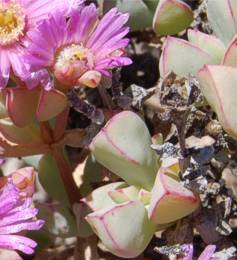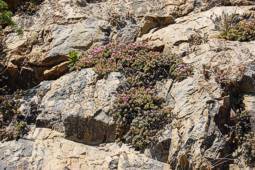Oscularia caulescens
Oscularia caulescens (Mill.) Schwantes
Family: Aizoaceae
Common names: dassievygie, sandsteenvygie (Afr.)
Introduction
Oscularia caulescens is an easy-to-grow succulent groundcover, ideal as an accent plant in especially rockeries or pots and for low-maintenance and water-wise gardens.

Description
Description
A robust, trailing perennial shrublet. The stems are succulent and reddish. The leaves are characteristically three-angled, sickle-shaped and grey-green, often tinged red in the drier season. This species, probably conspecific or related to O. deltoides, is distinguished by having teeth confined to the leaf margins and with leaves generally more robust than in O. deltoides.

The scented flowers are pink and are produced in the early summer (October-December) and open in the afternoon. Stamens are white below and pink above and are collected into a cone in the centre of the flower. Fruits open repeatedly when wetted and close when dry.
Conservation Status
Status
Oscularia caulescens is not regarded as threatened in its native habitat.
Distribution and habitat
Distribution description
Oscularia caulescens occurs exclusively on sandstone rocks, ranging along the mountains from Jonkershoek to Rooiels.
Derivation of name and historical aspects
History
Osculum means small mouth in Latin. Oscularia means a group of small mouths and probably refers to the compact arrangement of the young leaves of O. deltoides. Caulescens is the Latin word for caulescent, meaning, having a well-developed stem above ground. Currently 23 species of Oscularia are recognised in the Plants of Southern Africa online checklist (POSA).
The genus is confined to the winter rainfall areas of the Western Cape and is found mainly on sandstone outcrops, although a number of species also occur on granite.
Ecology
Ecology
Oscularia caulescens, like most of its congeners (other members of the genus), almost invariably occurs alone in rocky habitats. This could indicate an intolerance to competition by other plants or could also be a mechanism to escape the frequent fires in the fynbos.
Uses
Use
Oscularia caulescens is not widely used in horticulture, unlike the popular O. deltoides.

Growing Oscularia caulescens
Grow
Plants are easily cultivated from cuttings and are well suited to sunny rockeries and steep embankments or as accent plants in pots. Cuttings are best rooted when planted in sand, but can also be planted directly in the required beds. Seeds should be sown during autumn.
References
- Smith, G.F., Chesselet, P., Van Jaarsveld, E.J., Hartmann, H.E.K., Hammer, S., Van Wyk, B-E., Burgoyne, P.M., Klak, C. & Kurzweil, H. 1998. Mesembs of the world. Briza, Pretoria.
Credits
Matt H. Buys
Compton Herbarium, Kirstenbosch
December 2009
Plant Attributes:
Plant Type: Ground Cover, Succulent
SA Distribution: Western Cape
Soil type: Sandy
Flowering season: Spring
PH: Acid
Flower colour: Pink
Aspect: Full Sun
Gardening skill: Easy
Special Features:
Horticultural zones








Rate this article
Article well written and informative
Rate this plant
Is this an interesting plant?
Login to add your Comment
Back to topNot registered yet? Click here to register.